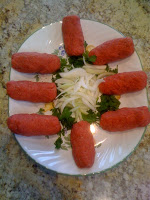
Every day must seem like Christmas morning for archaeologists in Armenia.
Recent discoveries include the world’s oldest shoe, the world’s oldest human brain and the remains of the world’s oldest wine-making operation.
Now comes evidence that the researchers have apparently dug their way into an ancient Armenian’s closet: The world’s oldest skirt, woven from reeds, has turned up not far from the shoe.
We’re betting on socks and underwear next. (We can’t wait to see what the world’s oldest vardiks look like.)
But even more interesting to us is that the same joint Armenian/American/Irish expedition has turned up a mummified goat believed to be at least 5,900 years old, more than 1,000 years older than any mummified animals in Egypt.
Few details emerged, as scientists have just begun to study the mummy. We’re wondering why any Armenian would go the trouble of preserving a dead goat?
The Egyptians, of course, were big believers in the after-life. A pharaoh’s entire household, including the servants and pets, all got tucked into the same tomb for expected re-animation in the next world.
Our completely unscientific guess is that the Armenian cave-dwellers had something less spiritual in mind for the goat. We figure they just hadn’t gotten around to eating it.
Without knowing details of the Armenian mummification process, we’re thinking: salt and fat. In other words, the world’s oldest kavourma.
Goat’s not usually on the menu at our house — but in case this latest discovery inspires you, here’s a thought:
Goat Stew:
Ingredients:3 pounds boneless goat, cubed
3 tablespoons butter
2 medium onions, coarsely chopped
2 carrots, coarsely chopped
2 celery stalks, sliced
½ cup dried brown lentils, picked over and rinsed
1 to 2 garlic cloves, minced
salt, pepper, and ground coriander to taste
1-6 ounce can tomato paste
2 cups water
1 cup white wine
Garnish: chopped parsley or cilantro
Directions:
1. Melt butter in a Dutch oven or large pot over medium heat; add meat in small batches, browning on all sides.
2. Stir in onion, carrots, celery, lentils, garlic, ground coriander, salt and pepper.
3. Dilute tomato paste in 2 cups water.
4. When vegetables begin to soften, add diluted tomato paste and wine; stir. Reduce heat and simmer – partially covered – for about 1-1/2 to 2 hours, or until goat is fork-tender.
5. Garnish with chopped parsley or cilantro.





I use goat often, boneless and on the bone. It really is very much like lamb, but without the strong 'lamby' flavor that some find unpleasant. So, it can be used interchangeably in all Armenian recipes that call for lamb, if you want less lamb taste.
Hello, how would you say the name of this recipe in Amrenian? I'm not Armenian, so cannot read it or speak it, but would like to be able to tell my neighbors what I made. :-). (I live in the Little Armenia neighborhood in Los Angeles).
Hi AnaZ, I confess that I do not speak Armenian, but as far as I know, the Armenian word for goat is 'aytsi'. Any stew, soup or meal in general is referred to as 'geragoor'. So, you might call this recipe 'Aytsi Geragoor'.